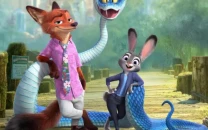Film review: The tree of life - never mind the dinosaurs
A word of advice, try not to be already depressed when you watch it...and let me know what you make of the dinosaurs.

With this film, critically acclaimed director Terrence Malick has gone back to the primordial source in more ways than one. He has chosen to explore life, death and everything that falls between these two polarities by employing the tree of life theme, but he has also returned to his own origins. His life began in the Midwest, he attended an Episcopalian school and went on to study and then teach philosophy. Tree of Life is an ode to his inherent “love of science, love of nature and love of God”. In a nod to his roots, the Biblical tone is strong; the film begins with a quote from the Book of Job, and is a powerful representation from an enigmatic filmmaker of macrocosm and microcosm, the Greek Neo-Platonic schema of seeing the same patterns reproduced in all levels of the cosmos from the macro level down to the micro. Man, in this schema, is the mid-point. Still with me? Then read on.
In the film we go on this exact journey; from extravagant visual voyages into the outer-planetary hemispheres, to the internal patterns of bacteria, organisms, atoms, returning to the being at the heart of it all — Man. This journey is vivid and hallucinatory — and it must be said, a lot of fun for those devoted cinephiles who live to gobble up such visual treats. But even such dedicated cinephiles may well feel that Malick may have gone too far with the gratuitous dinosaurs.
Man is represented by a ‘normal’, ‘decent’, hardworking all-American Midwestern family who suffer the loss of a young child. Malick forces us to meditate on death with his trademark heavy-handed devices which he utilises to great effect. He creates a complete psychogeography of the human condition using introspective voiceover almost exclusively. The cues or signals to the watcher of this film invariably come from the faces of the actors which one finds oneself staring at for inordinate lengths of time. It all feels very Kubrickian.
It can’t hurt that Malick made the choice to shoot in natural light wherever possible, a Kubrickian hallmark. Exquisite attention to the sound engineering is evident, and it is this that truly puts a finish on the flavour of the film. Most of it takes place outdoors, in a leafy, green suburb and the sound design does not let you out of that suburb for even a second; it holds you captive.
The result is something that is both alarmingly stifling and alarmingly expansive. The strong Christian over or undertones, depending on which way you look at it, however, distract from an idea that is more transcendent. The choice to use the all-too-familiar stars Brad Pitt and Sean Penn — has the odd effect of making the film less memorable rather than more. It’s the Warhol effect; lesser known faces would have suited the central conceit of the film better. Due to their considerable fame, it is difficult to perceive of them as anything other than the identities that they bring with them, no matter how hard they try to ‘act’. They’re great actors, but they are unable to transcend their egos, which is ultimately what is at the heart of the film.
If this has made no sense at all, then that’s a good thing, because you are now ready to watch Tree of Life. A word of advice, try not to be already depressed when you do...and let me know what you make of the dinosaurs.
Published in The Express Tribune, Sunday Magazine, August 28th, 2011.



















COMMENTS
Comments are moderated and generally will be posted if they are on-topic and not abusive.
For more information, please see our Comments FAQ